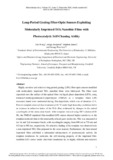JavaScript is disabled for your browser. Some features of this site may not work without it.
| dc.contributor.author | Wang, Tao | |
| dc.contributor.author | Korposh, Sergiy | |
| dc.contributor.author | James, Stephen | |
| dc.contributor.author | Lee, Seung-Woo | |
| dc.date.accessioned | 2021-01-25T16:08:28Z | |
| dc.date.available | 2021-01-25T16:08:28Z | |
| dc.date.issued | 2020-11-17 | |
| dc.identifier.citation | Wang T, Korposh S, James S, Lee SW. (2020) Long-period grating fiber-optic sensors exploiting molecularly imprinted TiO2 nanothin films with photocatalytic self-cleaning ability. Microchimica Acta, Volume 187, Issue 12, December 2020, Article number 663 | en_UK |
| dc.identifier.issn | 0026-3672 | |
| dc.identifier.uri | https://doi.org/10.1007/s00604-020-04603-1 | |
| dc.identifier.uri | https://dspace.lib.cranfield.ac.uk/handle/1826/16242 | |
| dc.description.abstract | Highly sensitive and selective long-period grating (LPG) fiber-optic sensors modified with molecularly imprinted TiO2 nanothin films were fabricated. The films were deposited onto the surface of the optical fiber via liquid-phase deposition (LPD), using tetrakis(N-methylpyridinium-4-yl)porphyrin (TMPyP) as a template. Three LPG resonance bands were monitored during film deposition, which was of duration 4.5 h. Prior to template removal, heat treatment at 60 °C under high-humidity conditions led to an increase in refractive index of the TiO2 film, evidenced by changes in the central wavelengths of the attenuation bands. After template removal using HCl solution (0.01 M), the TMPyP-imprinted film-modified LPG sensor showed higher sensitivity to the template molecule than to structurally related guest molecules. This was measured at the 1st and 2nd resonance bands, with wavelengths ranging from 690 to 738 nm and 815 to 905 nm, respectively. No selective binding of the template was observed with a non-imprinted TiO2 film prepared in the same manner. Furthermore, the heat-treated imprinted films exhibited a substantial enhancement of photocatalytic activity for template irradiation. In particular, the self-cleaning property of the imprinted film-modified LPG sensor under ultraviolet irradiation led to highly efficient and selective binding to the template. The mechanism of the interaction between the template and the TiO2 matrix was investigated by UV–vis and Fourier-transform infrared (FTIR) spectroscopies. Additionally, morphological studies using scanning electron microscopy (SEM) were conducted. | en_UK |
| dc.language.iso | en | en_UK |
| dc.publisher | Springer | en_UK |
| dc.rights | Attribution-NonCommercial 4.0 International | * |
| dc.rights.uri | http://creativecommons.org/licenses/by-nc/4.0/ | * |
| dc.subject | Long-period grating (LPG) | en_UK |
| dc.subject | Molecular imprinting | en_UK |
| dc.subject | Liquid-phase deposition (LPD) | en_UK |
| dc.subject | TiO2 nanothin film | en_UK |
| dc.subject | Photocatalyst | en_UK |
| dc.subject | Fiber-optic sensor | en_UK |
| dc.title | Long-period grating fiber-optic sensors exploiting molecularly imprinted TiO2 nanothin films with photocatalytic self-cleaning ability | en_UK |
| dc.type | Article | en_UK |
Files in this item
The following license files are associated with this item:
This item appears in the following Collection(s)
-
Staff publications (SATM) [4390]

